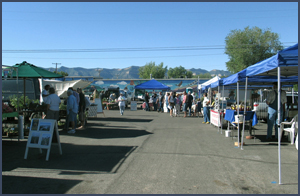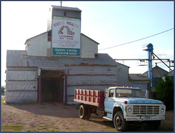Peoples of the Mesa Verde Region
Today: Mid-1900s to the PresentPeoples of European Descent

Main Street in Cortez, Colorado, in 2008. (See enlarged photograph; see also the same view in the early 1900s.) The majority of people living in the Mesa Verde region today are Americans of European ancestry (including Spanish). Some are descendants of early homesteaders, but many are newcomers, attracted to the area by its natural beauty, cultural diversity, and development opportunities. In the mid-twentieth century, most residents of European descent were engaged in agricultural pursuits, including farming and ranching. And while agriculture continues to play an important role in the early twenty-first century, today's residents also take full advantage of an economy that has expanded to include tourism, real estate, and energy development. 
Local growers sell fresh produce at farmers market early on a Saturday morning in Cortez. Mesa Verde is in the background. (See enlarged photograph.) The dominant governmental, educational, and religious institutions in the Mesa Verde region today are those of "mainstream America," typical of what one would find in any predominantly rural community in most parts of the United States. Small cities have grown up around centers of regional commerce, and even-smaller towns serve as focal points for outlying farming communities. Driving through any of the region's cities, one would find familiar sights—a "Main Street" business district, residential neighborhoods, public schools, places of worship, and skateboard parks. 
One of several city parks in Cortez. (See enlarged photograph.) Still, the region today consists mostly of open landscape, divided between large expanses of native vegetation, cultivated fields, and ranchland. And everywhere—from ancient sites in farmers' fields to the living descendants of those who came before—are reminders of the region's unique history and character, to which so many diverse cultures, both past and present, have contributed. |
|
Acknowledgments | Illustration credits | To borrow, cite, or request permission | Please take our survey! Title page for Peoples of the Mesa Verde Region |
|
 DONATE TODAY
DONATE TODAY


